Canon Rf 24-105mm F/4l Is Usm Lens Review
Canon RF 24-105mm F4 Fifty IS USM Lens Review
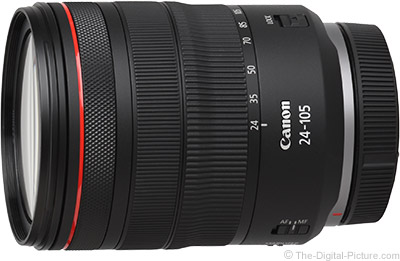
The Catechism RF 24-105mm F4 50 IS USM Lens is Canon'south first RF-mountain lens to hit the streets and the first kit lens to be included with Canon EOS R serial cameras. While "kit lens" may bring connotations of inexpensive and low quality, buyers of full frame imaging sensor cameras are discerning. Catechism understands that and does not disappoint with this one. Canon's EF-mount 24-105mm f/4L IS lenses are greatly-loved and take long been the choice for EOS full frame kit lenses, a lens typically needing keen general purpose functionality, and based on the success of those lenses, staying the course on the focal length range, quality level and general design for the EOS R-serial kit lens made a lot of sense.
The RF mountain is Canon's offset full frame lens mount introduced since the EF (electronic focusing) mount was introduced over xxx years agone. During that time flow, technology has increased greatly and the RF mount, while electric current-engineering science-optimized, provides a foundation for hereafter technology implementations.
With fantabulous image quality, fast and extremely accurate AF, a great general purpose focal length range and prototype stabilization along with solid build quality and a modest size, weight and price, the Canon RF 24-105mm F4 L IS USM is an extremely versatile lens and the perfect lens choice for the Canon R-series cameras it is designed for. If you lot could pack but one lens along with an R-serial camera for an anything-might-happen photo adventure, this lens will likely be your all-time option.
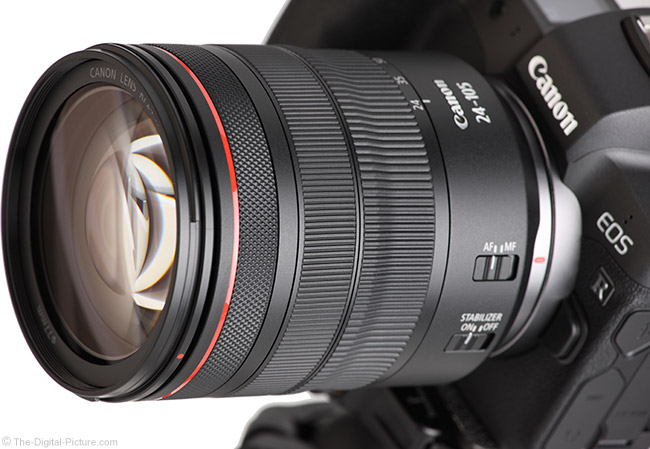
Focal Length Range
While bailiwick framing can exist adjusted by moving closer or farther abroad from the field of study, it is far better to select subject distance based on the ideal perspective it provides and that means the focal length is used to create the final discipline framing. The versatility to rapidly adjust that framing is the large advantage that a zoom lens provides. Still, having the correct focal lengths bachelor in a zoom lens remains paramount.
While super zoom lenses tend to rule in this regard, designers must make sacrifices to include farthermost focal length ranges in a single lens and those sacrifices typically negatively touch on image quality. The 24-105mm focal length range is not considered extreme by most, but it is relatively long (an over 4x zoom range). Though this focal length range still traverses the designer-challenging wide angle through telephoto range, the image quality capabilities of this range have, historically speaking, remained first-class.
While having a long range of focal lengths is helpful, what those focal lengths are is even more important, situationally more important at least. This lens' 24-105mm range covers a solid superset of the centre of the general purpose focal length range, which is roughly 28-70mm for a full frame photographic camera.
As the "general purpose" term indicates, the usefulness of the 24-105mm range is exceedingly high and the complete list of uses for this range is beyond my compilation abilities. The listing of what I personally have used this lens for is already long.

This lens is an ideal choice for landscape photography and mural photographers will find compositions ideally captured using every focal length available in this lens. The above image of the Maroon Bells was captured at 65mm. The Maui sunset beneath was captured at 24mm.

It is not hard to create compelling mural compositions using the 24mm perspective, while nonetheless providing emphasis on a foreground subject against an in-focus groundwork with the viewer feeling a sense of presence in the scene. At the other terminate of the range, 105mm works great for modestly-compressed landscapes featuring distant subjects such as mountains.

This is a great focal length range for photographing people and information technology is platonic for studio portraiture, weddings, parties, events, documentaries, interviews, lifestyle, fashion, some sports, candids and group and environmental portraits. Use the longer finish of the range for tightly-framed portraits and the shorter end for groups and environmental imagery.

This lens is a smashing choice for photojournalistic needs, it is ready to capture a wide range of product images and it is well-suited for commercial photography in full general.
Practise you travel? If so, this lens (especially with its pocket-size size and light weight) is perfectly suited for documenting your travels and capturing images that volition look great adorning your walls. This lens is ready to capture interior and outside compages, cities, countrysides, flowers, etc.

At review time, this lens is non uniform with any APS-C (1.6x FOVCF) format cameras. Should that fact change in the future, or should an R-serial cameras' 1.6 ingather mode exist used, the full frame bending of view equivalent will exist 36-157.5mm. This range is somewhat lacking from a broad bending perspective, simply it has a very attractive long end. If your focal length needs gravitate toward the long finish, a 24-105mm lens with an APS-C bending of view volition be very useful to you.
Here is another example of what this focal length range looks similar:

Those are nifty angles of view and the range is a strong ane. Pay specific attention to the 70mm vs 105mm comparison as that is the difference betwixt what this lens offers and what the to-70mm culling lenses provide.

Max Aperture
The f/4 in the lens name refers to the lens' max discontinuity opening, the relationship of lens opening to focal length. The lower the number, the more low-cal the lens will permit to accomplish the sensor. Each "terminate" in aperture alter (examples: f/two.8, f/4.0, f/v.6, f/8, etc.) increases or reduces the amount of light reaching the sensor by a factor of 2x (a big bargain).
An F4 Lens is 1 terminate slower/narrower than what is typically found in the fastest/widest zoom lenses covering the full general purpose focal length range and two stops slower/narrower than the groundbreaking Canon RF 28-70mm F2 L USM Lens. The narrower max aperture ways that less drinking glass is needed, resulting in lighter weight, smaller size and lower cost. Having a narrower max aperture too means that in that location may be improve options for stopping action in low light, such as the Canon EF 24-70mm f/two.8L II USM Lens or the simply-mentioned 28-lxx. I emphasize "action" as this lens' image stabilization system (discussed before long) makes this lens even ameliorate-suited for handheld low light non-action photography than a non-stabilized f/2.viii or even f/2 option. Of grade, the field of study speed and how rapidly that subject area is crossing pixels in the frame makes depression lite capabilities situational.
Long focal lengths, broad apertures, close subjects and afar backgrounds are the keys to a strong background blur. While the f/four discontinuity is not extremly wide, the 105mm f/four combination, along with a relatively shut subject and distant groundwork, is able to produce great subject separation by blurring away the background.

That is an instance of the near-maximum groundwork blur this lens can produce. Information technology is very satisfying to see the background melt into a blur of color.
In a zoom lens, the max aperture will sometimes be stated as a range, indicating that the max aperture narrows as the focal length increases. This is not the case with any of Canon'south 24-105mm L lenses produced to date and this ane once again features the highly-desirable abiding f/4 max aperture. Manually-set up broad open exposures can be retained and counted on throughout the entire zoom range.
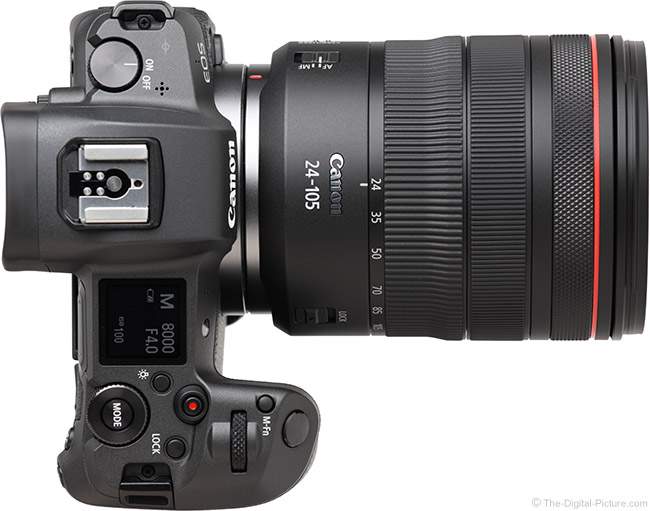
Prototype Stabilization
A feature I discover crucial in a walk-effectually general purpose lens is image stabilization. Unless I am using a camera support, I seldom leave home without IS and I usually regret those times I do. While image stabilization does not stop subject field motility, information technology allows handholding of the camera in extremely low calorie-free situations with notwithstanding subjects (or permits motion blurring of subjects with sharp surroundings such as flowing water). The image quality difference made past IS is potentially dramatic.
One state of affairs that I am frequently counting on IS for assist with is when handholding in medium and depression light levels when more depth of field is needed, assuasive narrower discontinuity use without a tripod. When using a circular polarizer filter with narrow apertures (typical for landscapes and cityscapes), IS tin can exist helpful even under a full sunday. I oftentimes discover myself trail running while hiking with a camera and family unit/friends (that don't wait for me) and when I terminate to shoot, I am oft breathing difficult and non steady. IS makes that piece of work.
IS is useful for stabilizing the viewfinder, aiding in optimal composition. IS is also very useful for video recording, helping to avoid motion sickness in susceptible viewers.
Catechism's image stabilization systems have improved dramatically since first introduced. This IS implementation makes a very faint "hmmm" with some clicks while active, audible only from most an inch or two from the lens. Canon's IS systems have long been very well behaved, meaning that the viewfinder image does not jump and I do not find myself fighting against IS while recomposing or recording video. I accept not noticed the prototype frame globe-trotting while IS is active.
In addition to general refinements, the rated number of stops of aid provided by this IS system has been improved from its EF predecessor. The RF 24-105mm F4 50 lens gets a very-high v-stops of help rating. Improved communications between the lens and the camera via the new RF mount has made this impressive rating possible. For example, based on this rating, an ISO setting 5 stops higher, ISO 3200 instead of ISO 100 or ISO 25600 instead of ISO 800 for example, would be necessary to increase the shutter speed enough to recoup for the help provided by this system. That divergence is huge in terms of paradigm quality.
At 24mm, with the help of image stabilization, I am getting a high keeper rate with 0.4 second exposures, a still good rate at 0.five seconds and even a reasonable percentage at 0.eight seconds. The keeper rate drop-off is gradual as shutter speeds lengthen. At 105mm, I had very good results with 0.iii second exposures, still had a decent rate of sharp images at 0.4 seconds and enough were sharp at 0.5 seconds that I would certainly endeavour this.
These numbers should be considered about the best I can practice. While I'm not the steadiest photographer, testing is done under ideal weather condition, indoors on a concrete floor. Quickly hike up a big mountain and shoot from an unstable position in strong winds and a significantly faster shutter speed is going to exist needed. Even so, the amount of assistance should remain like and that is very important.

Image Quality
If y'all are using a full frame interchangeable lens camera, you care most image quality. And your paramount question is probably "How abrupt is the Canon RF 24-105mm F4 50 IS USM Lens?"
"Quite sharp" is the reply, about the same as or slightly meliorate than the Canon EF 24-105mm f/4L Ii lens. In the central portion of the frame, RF 24-105mm F4 L IS images accept good sharpness that remains remarkably similar throughout the focal length range and unusually like across the aperture range – until diffraction begins to bear upon (soften) the results at narrower apertures. The site'southward epitome quality tool provides a great view of this lens' performance, but allow's take a wait at some 100% heart-of-the-frame crops from an outdoor scene. The following images were captured in RAW format and candy in Catechism'southward DPP (Digital Photo Professional person) software using the Standard Picture Fashion and, keeping in listen that fifty-fifty modestly-high sharpness settings are destructive to paradigm details and hide the true characteristics of a lens, sharpness was ready to "2".

Those results wait very dainty to me equally accept my real earth images. Basically, these results say that, with this lens, you can freely select the ideal aperture for your image with little regard to prototype sharpness. That is a great feature.
Note that at 105mm, there is some focus shift rearward equally the aperture is stopped down. The focused-on subject area remains abrupt, but most of the depth of field is added backside the subject. Wider angles show a more than even front-to-back depth of field increase.
The total frame corner operation from this lens is quite adept, impressively good for a zoom lens with this focal length range. Following are 100% extreme corner crop examples (captured and processed the aforementioned every bit the to a higher place). bottom-left for the 24mm and kickoff 105mm results, acme-left for the 50mm and second set of 105mm images.

The wider 2 sets of results are quite squeamish. The 105mm results show some softness, simply detect that lateral CA (hands correctable) is causing misaligned colors in these samples.
Information technology is expected that a lens will show some peripheral shading at its widest aperture when used on a camera utilizing the full image circle. The amount, notwithstanding, is a variable.
Expect a relatively loftier almost-3.4 stops of shading in the corners at 24mm f/4. Past 35mm, the shading amount drops significantly to most two stops (relatively low). At 50mm, the shading amount drops slightly to about i.7 stops. At 70mm, the amount is again slowly climbing, reaching just over ii stops and from 85mm through 105mm, vignetting is roughly 2.v stops in the extreme corners.
Want less peripheral shading from a lens? Using a narrower discontinuity is nearly universally the respond. At f/5.6, this lens shows 2.5, 1.6, 1.4, one.4, one.v and one.six stops of shading at the marked 24, 35, fifty, lxx, 85 and 105mm settings respectively. At f/8, those numbers are 2.0, 1.4, 1.0, ane.0, 0.8 and 0.8. Wait little or no decrease at narrower apertures.
A rough rule of thumb says that shading above 1 stop is sometimes noticeable (though even less may be noticeable on a blueish sky or similar). Manifestly, even at f/8 and narrower apertures, these shading numbers are still close to or above visibility levels.
Vignetting can hands be corrected during post processing or in-camera with increased racket in the brightened areas being the penalization and y'all volition likely encounter scenarios where this correction is desired. Vignetting can likewise be simply embraced, using the issue to draw the viewer'due south eye to the middle of the frame.
As I have often repeated, if lens elements refracted all visible wavelengths of calorie-free identically, a lens designer's job would be a lot easier. They do non and we get aberrations caused by various wavelengths of light being magnified and focused differently.
The outcome of different colors of the spectrum being magnified differently is referred to as lateral (or transverse) CA (Chromatic Abnormality). Lateral CA shows as color fringing along lines of strong contrast running tangential (meridional, right angles to radii) with the mid and particularly the periphery of the image circle showing the greatest corporeality every bit this is where the greatest difference in the magnification of wavelengths exists.
While lateral CA is usually hands corrected with software (ofttimes in the camera) by radially shifting the colors to coincide, information technology is of course better to non accept it in the first place. Any color misalignment present tin can easily exist seen in the site'south prototype quality tool and this lens shows impressive operation in that challenge with the 105mm corners beingness the exception. I was able to coax more than color fringing from this lens at longer distances every bit shown below. Illustrated are worst-instance examples, 100% crops from the extreme top left corner of EOS R frames.

Zoom lenses generally accept lateral CA showing the strongest at the two ends of the focal length range and that is the instance here. The RF 24-105 F4 L IS transitions from a moderate amount of lateral CA at 24mm to a negligible amount in the midrange and back to a rather strong amount once again at 105mm.
As mentioned, lateral CA tin can exist corrected with software. With the proper lens profile loaded in Canon DPP, removing lateral CA is as easy as checking a box and removal is similarly piece of cake in other tools.
A relatively mutual lens aberration is centric (longitudinal, bokeh) CA, which causes non-coinciding focal planes of the various wavelengths of light, or more only, dissimilar colors of light are focused to different depths. Spherical aberration along with spherochromatism, or a change in the corporeality of spherical abnormality with respect to color (looks quite similar to axial chromatic aberration, just is hazier) is another common lens abnormality to look for. Axial CA remains at least somewhat persistent when stopping down with the color misalignment outcome increasing with defocusing while the spherical aberration color halo shows petty size change every bit the lens is defocused and stopping downwardly one to two stops by and large removes this aberration.
In the real globe, lens defects do non exist in isolation with spherical aberration and spherochromatism by and large found, at to the lowest degree to some caste, along with centric CA. These combine to create a less sharp, hazy-appearing prototype quality at the widest apertures. Shown beneath are 100% EOS R crops taken from the middle of the frame. Look for fringing colour differences in blurred details in the foreground vs. the background in these images.

At 24mm and 50mm, the foreground and background blur colors appear about the same and that is what nosotros want to come across. At 105mm, the results are yet looking very adept, though a hint of departure shows.
This lens features Canon's Air Sphere Coating (ASC) and Super Spectra blanket, designed to reduce flare and ghosting. Lens flare occurs when a bright light source is within or just outside the prototype frame, resulting in internal reflections from lens elements appearing in the image. Flare effects tin be embraced, avoided or removal can be attempted. If not embraced, flare effects tin can be destructive to image quality and these are sometimes extremely difficult to remove in post processing.
Our standard flare test involves placing the sunday in the corner of the frame and in this examination, the RF 24-105mm lens performed very well at f/four with only small flare effects being noticed. Flare effects are ordinarily most pronounced at narrow apertures and by f/16, this lens is indeed showing stronger flare effects. However, the effects are relatively mild and not unusual.
At that place are 2 lens aberrations that are especially axiomatic when shooting images of stars, mainly because bright points of light against a nighttime background make them easier to see. Coma occurs when calorie-free rays from a signal of light spread out from that signal, instead of being refocused every bit a signal on the sensor. Blackout is absent in the center of the frame, gets worse toward the edges/corners and generally appears as a comet-like or triangular tail of light which tin can be oriented either away from the center of the frame (external coma) or toward the center of the frame (internal coma). Coma becomes quite visible mid-frame and in the corners of images captured at wide apertures and significantly resolves when the lens is stopped down. Astigmatism is seen as points of light spreading into a line, either sagittal (radiating from the center of the image) or meridional (tangential, perpendicular to sagittal).
The following 100% crops were taken from the acme right corner of an EOS R frame centered on the north star.

At 24mm, the stars retain a very skillful circular shape. The piffling circles are nonetheless looking decent at 35mm merely start growing wings at 50mm. The weakest performance is at 105mm where little rocket planes seem to be taking shape.
From a geometric perspective, this lens has barrel baloney at the wide end that transitions into negligible distortion and on into pincushion distortion at the long end. That description is applicable to practically all general purpose zoom lenses. The corporeality of barrel distortion at 24mm is modest and less than seen in Canon's previous 24-105mm lenses. The pincushion baloney at 105mm is moderate in strength and about the same as seen in Canon'southward other 24-105mm lenses, though the pincushion distortion at 50mm is slightly less.
Virtually modern lenses have lens correction profiles available for the pop image processing software and distortion can be easily removed using these, but distortion correction is destructive at the pixel level and this technique is seldom equally practiced as using a distortion-free lens and focal length combination in the first place.
While we already established that this lens can create a strong background blur, the quality of that blur, referred to as bokeh, can also matter. Here are some examples.

The first iii examples are 100% crops showing out-of-focus (background) specular highlights captured at f/8. At 24mm, creating a strong groundwork blur at narrow apertures where bract involvement is visible is challenging. However, it is not so challenging at 105mm. While all iii examples are decent for their focal length class, the longer focal lengths are creating a larger and nicer-actualization mistiness circumvolve.
The 4th and fifth examples were besides captured at f/8, both outdoors. The 24mm example is a 100% crop and the 105mm case shows an unabridged prototype reduced in size. Both of these examples announced nice.
The last example is an f/iv corner ingather looking for true cat's eye (non round) bokeh, a form of mechanical vignetting.
With an discontinuity bract count of 9, distant signal light sources captured with a narrow aperture and showing a star-similar effect will have 18 points.
Why does an odd-numbered discontinuity blade count produce twice equally many points on the stars as an fifty-fifty number? The points on these stars are coming from the blades of the aperture. Each blade is responsible, via diffraction, for creating 2 points of the star effect. If the blades are arranged opposite of each other (an even blade count), the points on the stars will equal the blade count, every bit two blades share in creating a single pair of points. The blades of an odd blade count aperture are not opposing and the upshot is that each bract creates its ain two points. Nine blades times 2 points each create 18-point star effects.
A nifty technique for including the sun in a frame is to partially hide it and use a narrow aperture setting. Here is an example from this lens:

That star looks nice to me.

The vignetting is a bit stiff and the focal length extremities show the usual lateral CA, but overall, this lens delivers abrupt imagery and it has the optical quality needed for a professional-class general purpose lens.
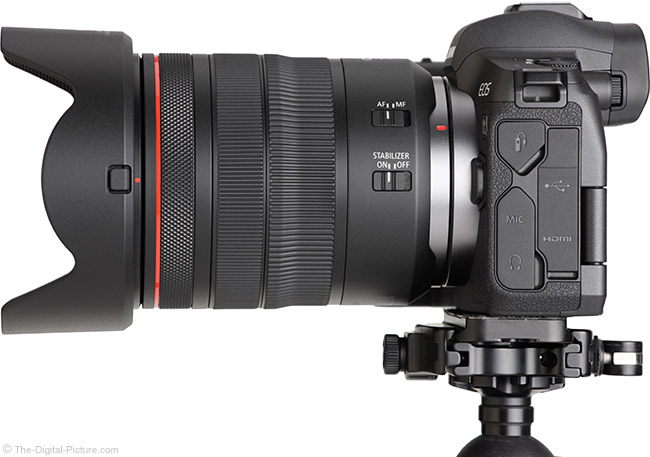
Focusing
Unless manual focusing is being utilized, the combined performance of a camera and lens' autofocus system is critical to realizing the potential image quality of the combination. The Catechism RF 24-105mm F4 L IS USM Lens receives a high-performing Nano USM (Ultrasonic Motor) driven AF arrangement equally showtime seen in the Canon EF-South 18-135mm f/3.5-5.vi IS USM Lens.
Nano USM acts similar an ultra-fast version of STM AF, combining the benefits of a high speed Ring USM actuator with an STM organization stepping motor's tranquility and smooth, directly, lead spiral-type drive organization. Like Band USM driven AF systems, Nano USM focuses extremely fast. With this lens mounted on an EOS R and the Canon EF 24-105mm f/4L IS II USM Lens mounted on an EOS 5Ds R, I could non discern which combination focused faster in side-by-side testing. Like STM AF systems, Nano USM focuses almost silently, with merely faint clicking heard with one's ear next to the lens. And, Nano USM lenses focus very smoothly.
Canon U.South.A.'s Rudy Winston states: "Canon's new Nano USM technology uses a completely different form factor, but achieves focus results inside the lens via the same principles of ultrasonic vibration energy, transmitted here into linear (rather than rotational) movement inside the lens. This tiny new Ultrasonic motor achieves the combination of fast, nigh-instant response during still image shooting, with the smoothness required for skilful focus during video recording."
Band USM was Catechism'southward former preference for high-cease lens AF systems. While nearly Band USM lenses are great performers, they generally exercise not focus so smoothly in Motion-picture show Servo AF, and the Band USM EF lenses produce considerably more focus churr. Nano USM (and STM) lenses autofocus substantially smoother and quieter than Ring USM lenses.
I mentioned in the EF-S eighteen-135mm IS USM review that the AF operation from the beginning Nano USM lens predicted more than Nano USM lenses coming and with the RF 24-105, this proven applied science has at present landed in the highly-regarded 50 Series.
AF accuracy from the Canon RF 24-105mm F4 L IS USM Lens has been very impressive.
The focus ring is mid-sized and positioned in front of the zoom band (this is my strongly-preferred position).
Like STM, Nano USM utilizes a focus-by-wire or electric transmission focus design (vs. a straight gear-driven system). The manual focus ring electronically controls the focus of the lens. FTM (Full Time Manual) focusing is supported in AF mode with the camera in One Shot Drive Fashion, just the shutter release must be half-pressed for the focus band to become active. Note that FTM does not piece of work if electronic transmission focusing is disabled in the camera's menu (if this pick is present). The lens' switch must be in the "MF" position and the camera meter must exist on/awake for conventional transmission focusing to exist available.
With electronics driving AF, the charge per unit of focus change acquired by the focus ring can be electronically controlled and it can be variable, based on the ring'south rotation speed. I never acclimated to that feature and with the R-series cameras, a linear adjustment speed can be configured. That's my preference and in this mode, the RF 24-105 F4 L focus is adjusted very slowly, with more than 360° of ring rotation from MFD to infinity, for very precise focusing capabilities.
The transmission focus ring has an ideal resistance and adjustments are polish and solidly centered with no unusual framing shift happening. Only slight bailiwick magnification/framing changes are seen in full extent focus range changes.

This lens maintains (naturally or, more likely, electronically) the proper focus distance throughout the unabridged zoom range (parfocal). Change the focal length after focusing and it appears to remain properly set.
Cameras featuring Dual Pixel CMOS AF and Moving-picture show Servo AF make video recording very piece of cake and Nano STM lenses are very well-suited for this task. The smooth focusing makes focus altitude transitions easy on the viewer's eyes and the audio of the lens focusing is not picked up by the camera'southward mic. Fifty-fifty the lens' aperture changes are placidity and smooth.
No focus distance scale is provided on the lens, simply a digital calibration can be enabled in the electronic viewfinder or LCD. The RF 24-105'southward focus ring is relatively modest only large enough to be quite useful.
The RF 24-105mm F4 50 has a 17.seven" (450mm) minimum focus distance (MFD) that delivers a 0.24x maximum magnification (MM) at 105mm. These are very skillful numbers overall and average for the class.
| Model | MFD | MM | |
| Canon RF 24-105mm F4 L IS USM Lens | 17.7" | (450mm) | 0.24x |
| Canon EF 24-105mm f/4L IS II USM Lens | 17.7" | (450mm) | 0.24x |
| Canon EF 24-105mm f/3.5-v.6 IS STM Lens | 15.7" | (400mm) | 0.30x |
| Catechism EF 24-70mm f/2.8L Two USM Lens | 15.0" | (380mm) | 0.21x |
| Canon EF 24-70mm F4 50 IS USM Lens | seven.9" | (200mm) | 0.70x |
| Nikon 24-120mm f/3.v-5.6G AF-South VR Lens | 19.two" | (488mm) | 0.21x |
| Nikon 24-120mm f/4G AF-S VR Lens | 17.7" | (450mm) | 0.24x |
| Sigma 24-105mm f/4.0 DG OS HSM Art Lens | 17.7" | (450mm) | 0.22x |
| Sony FE 24-105mm f/4 Yard OSS Lens | 15.0" | (380mm) | 0.31x |
Figure a subject measuring 5.three ten iii.five (135 x 89mm) filling the frame at 105mm at minimum focus distance. The orchid in the maximum mistiness prototype shared earlier in the review measures near 3.25" (83mm) in width and was rendered quite big in the frame.
Magnification from wide angle through standard/normal focal length lenses is generally significantly increased with the use of extension tubes, hollow tubes with electronic connections that shift a lens farther from the camera. As of review time, RF mount-uniform extension tubes do not exist. Watch for this accessory to go available.
The Canon RF 24-105mm F4 L IS USM Lens is not compatible with Canon extenders.

Build Quality & Features
While Canon'due south RF L lenses have on a slightly updated expect, those familiar with EF L lenses will immediately recognize this lens' heritage, including the high quality structure.

With polish external dimensions and tight tolerance between parts, the Canon RF 24-105mm F4 L IS USM Lens is very comfy to hold and use. A slight bore increase on the zoom ring makes it like shooting fish in a barrel to detect. With the RF lenses gaining an additional ring, finding the right ring is modestly more complicated and tactile cues, especially this one, are helpful.
The additional ring is the knurled "Control Band", able to be configured for fast access to settings including aperture, ISO, and exposure bounty. Note that the control band is clicked by default and this ring'south clicks are going to be audible in photographic camera-based sound recordings. Catechism offers a click stop removal service for this ring (at a toll).
The rear-positioned zoom ring is ideally-located, behind the focus ring. The smooth-performance zoom and focus rings are immediately adjacent to each other with a minor amount of space provided between the focus band and control ring.
This lens features a quality plastic external construction. As illustrated in many of the product images in this review, this lens extends when zoomed to 105mm. The extended inner lens barrel has a slight amount of play. A switch is provided that locks the lens at the retracted 24mm length, preventing gravity extension that wasn't a problem on the examination lens.
The AF/MF and IS switches are flush-mounted and low-contour, merely just plenty raised surface expanse is available for like shooting fish in a barrel use, fifty-fifty with gloves. Interesting is that changing the AF/MF switch position opens the lens aperture momentarily when the camera is powered off and that the lens makes a faint dissonance (ear against the lens required to hear information technology) when the camera is powered up.
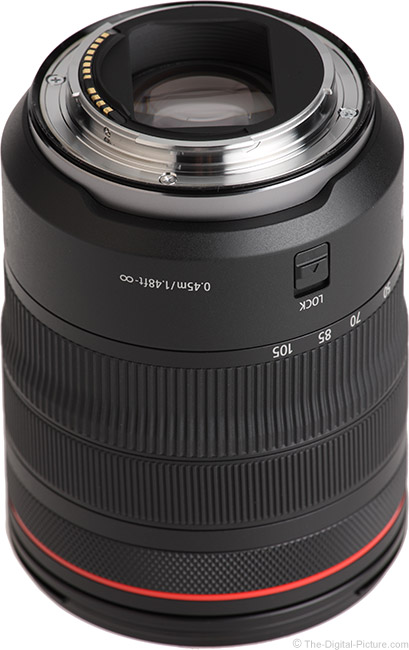
This is a weather-sealed lens, but don't confuse this feature with waterproofness. Notwithstanding, weather sealing can sometimes relieve the day. I've used this lens in lite rain and snow with no problems to date.

Similar most other recent L lenses, the RF 24-105 f/iv features fluorine coatings on the front and rear lens elements to avoid grit adhesion and to brand cleaning easier. This is 1 of those features that goes unnoticed until something happens in the field.
The size and weight of this lens are very comfy and ideal for even long-term employ. My 16-year-sometime daughter carried it on hikes as long as 7 miles with significant superlative gain and later remarked about it beingness easy to have along.
| Model | Weight | Dimensions west/o Hood | Filter | Year | ||
| Canon RF 24-105mm F4 L IS USM Lens | 24.seven oz | (700g) | 3.3 10 four.2" | (83.5 x 107.3mm) | 77mm | 2018 |
| Canon EF 24-105mm f/4L IS Two USM Lens | 28.i oz | (795g) | 3.3 x iv.6" | (83.5 x 118.0mm) | 77mm | 2016 |
| Canon EF 24-105mm f/3.5-5.6 IS STM Lens | eighteen.5 oz | (525g) | iii.three 10 four.ane" | (83.4 x 104.0mm) | 77mm | 2014 |
| Canon EF 24-70mm f/2.8L II USM Lens | 28.iv oz | (805g) | three.5 x four.four" | (88.5 x 113.0mm) | 82mm | 2012 |
| Canon EF 24-70mm F4 L IS USM Lens | 21.2 oz | (600g) | three.3 x 3.7" | (83.4 x 93.0mm) | 77mm | 2012 |
| Nikon 24-120mm f/three.5-v.6G AF-S VR Lens | 20.3 oz | (575g) | 3.0 x iii.seven" | (76.2 x 93.98mm) | 72mm | 2003 |
| Nikon 24-120mm f/4G AF-S VR Lens | 23.7 oz | (670g) | 3.iii x 4.1" | (84.0 x 103.0mm) | 77mm | 2010 |
| Sigma 24-105mm f/4.0 DG OS HSM Art Lens | 31.ii oz | (885g) | three.5 x 4.3" | (88.6 x 109.4mm) | 82mm | 2013 |
| Sony FE 24-70mm f/4 ZA OSS Lens | xv.2 oz | (430g) | 2.9 x 3.7" | (73.0 10 94.5mm) | 67mm | 2014 |
| Sony Iron 24-105mm f/four G OSS Lens | 23.4 oz | (663g) | three.three x 4.five" | (83.4 x 113.3mm) | 77mm | 2017 |
For many more comparisons, review the complete Canon RF 24-105mm F4 L IS USM Lens Specifications using the site's Lens Spec tool.
Apparently, the RF lens shed some size and weight from the EF predecessor. Here is a visual comparison:

Positioned above from left to correct are the following lenses:
Canon EF 24-105mm f/3.5-5.6 IS STM Lens
Canon RF 24-105mm F4 L IS USM Lens
Sigma 24-105mm f/4.0 DG OS HSM Art Lens
Sony FE 24-105mm f/four Thousand OSS Lens
Canon EF 24-105mm f/4L IS 2 USM Lens
The aforementioned lenses are shown below at max extension with their hoods in identify.
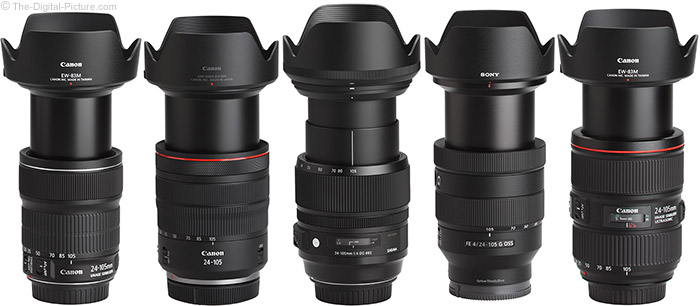
Use the site's product image comparison tool to visually compare the Canon RF 24-105mm F4 L IS USM Lens to other lenses.
Non obvious in the above comparisons is that a Catechism Mount Adapter EF-EOS R is required to mount any of the EF-uniform lenses to RF-mount cameras (the EOS R-series), the only cameras the reviewed lens is compatible with. This adapter adds .9" (24mm) in length and three.9 oz (110g) in weight to any of the adaptable lenses. Here is a mounted comparing between the RF and EF lenses:

The difference is actualization substantial here and one of the advantages of the RF mountain's brusk flange back altitude is clear.
The Canon RF 24-105mm F4 L IS USM Lens utilizes the ultra-common 77mm-sized threaded filters. While this filter size is not peculiarly small, that this size is likely shared among multiple lenses in your kit means that fewer filters may be needed in some scenarios and fewer in this case means less space and lower cost. A standard thickness UV or Clear Lens Protection Filter will cause very slightly increased vignetting at 24mm. This outcome is fifty-fifty more than pronounced with circular polarizer filters as they accept thicker rims than protective filters and increased peripheral shading is even visible at stopped down apertures. Definitely go slim filters such as the B+West XS-Pro and Breakthrough X4 models for this lens.

Catechism includes lens hoods for all L-serial lenses and, with very few exceptions, you should ever use them (and not in reversed position). The EW-83N is the hood model that comes with this lens. This is a semi-rigid plastic petal-shaped hood with a ribbed interior designed to avoid reflections. It offers a good amount of protection, both from impact and, especially at broad focal lengths, from bright low-cal.
Catechism includes the soft-side LP1319 drawstring pouch in the box. This pouch offers protective padding on the bottom, just the sides are unpadded, offering calorie-free scratch and grit protection.

This lens comes with the very nice Catechism E-77 2 lens cap that has been shipping with other recent Canon 77mm-capped lenses. Along with the RF mount Canon introduced a new mountain cap, the robust Lens Dust Cap RF.
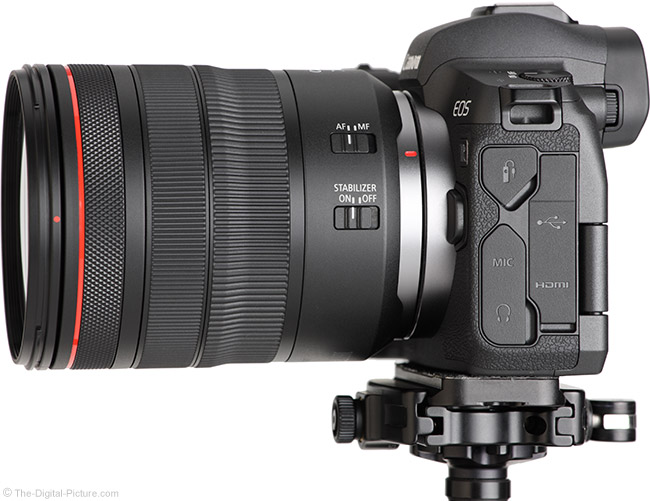
Price and Value
The Canon RF 24-105mm F4 L IS USM Lens has the aforementioned moderate toll as its EF counterpart. The versatility of this lens gives information technology great value at the offered price.
As an "RF" lens, the Canon RF 24-105mm F4 L IS USM Lens is uniform only with Catechism EOS R series cameras. Canon U.s.a. provides a 1-year limited warranty.
The reviewed Canon RF 24-105mm F4 L IS USM Lens was a production model on long-term loan from Canon USA.
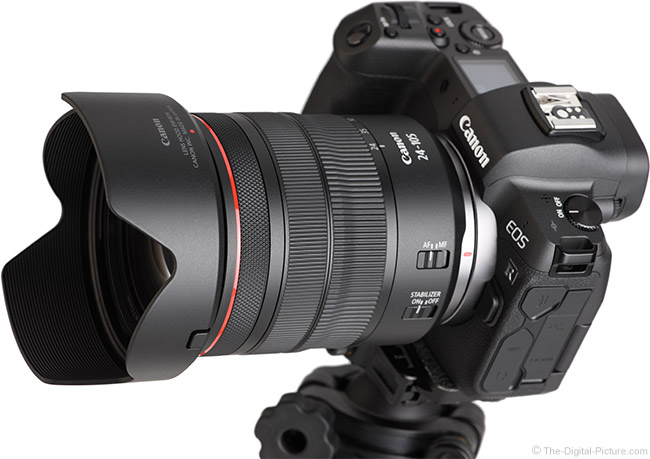
Alternatives to the Canon RF 24-105mm F4 Fifty IS USM Lens
At review time, if y'all accept an EOS R-series camera, the Canon RF 24-105mm F4 L IS USM Lens is the best relatively lightweight, moderately priced, general-purpose lens choice.
The RF 24-105 L lens was introduced with Canon's first mirrorless photographic camera, the EOS R. Since that time, additional Canon general-purpose RF lenses were introduced.
Let's look at the Canon RF 24-70mm F2.eight L IS USM Lens outset. This lens features the same L-class build and performance, optical performance included. The 24-lxx gives up some focal length range, but offers a twice-equally-large aperture opening.
The image quality comparison at f/2.8 vs. f/4 shows both lenses sharp at their broad open up apertures. The f/4 lens is a bit sharper in the periphery, and the f/ii.viii pick is slightly sharper in the eye of the frame. At 70mm, the 24-105 takes the center advantage also. Equalized at f/4, these lenses volition challenge you to notice whatever differences, save at 50mm where the 24-105mm examination lens appears a bit sharper in the periphery. From a sharpness perspective, information technology doesn't matter which lens you lot are using at f/5.6.
Despite having a 1-end wider aperture, the f/two.8 lens does not hold a peripheral shading advantage. The f/ii.8 lens has less geometric distortion.
Looking at the specs and measurements, the Canon RF 24-105mm F4 L IS USM Lens vs. Canon RF 24-70mm F2.8 50 IS USM Lens comparing shows the f/4 lens being moderately smaller and lighter and also having smaller filter threads (77mm vs. 82mm). The f/2.8 lens has a much shorter minimum focus distance (8.three" vs 17.vii" / 210mm vs. 450mm) and higher maximum magnification (0.30x vs. 0.24x). Equally mentioned, the f/ii.viii lens has a significantly wider discontinuity. The f/4 lens has a noticeably longer focal length range, and quite noticeable is the lower price tag.
A lower-cost, focal-length-equivalent option is the Catechism RF 24-105mm F4-7.i IS STM Lens, sharing the same maximum aperture opening. While the shared max aperture opening sounds skilful on the surface, the STM lens's f/4 aperture is only available for the widest three mm of the focal length range, and the L lens is a very significant 1 2/3 stops wider at focal lengths over 79mm.
In the image quality comparison, the Fifty lens is noticeably sharper. The Fifty lens has dramatically less geometric baloney at 24mm, though it shows slightly more than flare at this focal length.
Looking at the specs and measurements, the Canon RF 24-105mm F4 50 IS USM Lens vs. Canon RF 24-105mm F4-seven.1 IS STM Lens comparison shows the STM lens to be considerably smaller and lighter. The Fifty lens has nine aperture blades (vs. vii) and larger filter threads (77mm vs. 67mm). A Nano USM AF system powers the L lens focusing, while the STM lens uses an ... STM system. The STM lens has a higher maximum magnification (0.50x vs. 0.24x), though the STM'southward peripheral image quality is not adept when used at the highest magnification. The price is another differentiating STM lens advantage, costing 36% every bit much (list price at review time).
If you already have a similar lens that can be adapted to the RF-mount cameras, economics come into play.
More specifically, the Catechism EF 24-105mm f/4L IS 2 USM Lens is what I've been referring to as the RF lens's predecessor, primarily considering it was the most-recent-prior-introduced 24-105mm F4 L lens, and it is the most-similar alternative. The image quality comparison may convince you to brand the switch to the mirrorless camera just to enable use of this lens. The RF lens is noticeable sharper over the range. The RF lens has slightly less linear distortion, while the EF lens has less vignetting.
We have already established that the RF lens is smaller and lighter. Looking at the specs and measurements, the Canon RF 24-105mm F4 L IS USM Lens vs. Canon EF 24-105mm f/4L IS II USM Lens comparison shows the RF getting one less aperture bract (ix vs 10). The RF lens has Nano USM vs. Band USM for quieter and smoother performance and much longer focus band rotation (400° vs. 122°). The RF lens' IS system is rated for one additional stop, 5 vs. 4. The RF includes a command band, simply information technology is not able to exist used on not-EOS-R-serial cameras.
Another corking Canon general purpose lens is the Canon EF 24-70mm F4 L IS USM Lens. I've gone back and forth betwixt the EF 24-70 and 24-105 F4 50 IS lenses, and until switching to mirrorless, I owned both and still don't know which is my favorite. With the EF 24-105 beingness similar to the RF 24-105, the Should I get the Canon EF 24-70mm F4 L IS or 24-105mm F4 L IS II Lens? commodity covers the additional differences.
The Canon RF 24-105mm F4 Fifty IS USM Lens vs. Canon EF 24-70mm F4 L IS USM Lens specs and measurements comparison show differences directly.
The Which 24-105mm Lens Should I Get? article includes the Catechism EF 24-105mm f/iii.v-v.half-dozen IS STM Lens in the comparison with the EF L lenses and remains applicative with understanding of the RF lens differences. Here is the Canon RF 24-105mm F4 L IS USM Lens vs. Canon EF 24-105mm f/3.5-5.6 IS STM Lens specs and measurements comparing. The STM lens is the much cheaper option. The L lens is noticeably sharper.
Leaving the Canon family unit, we have the Sigma 24-105mm f/four.0 DG OS HSM Art Lens as a good selection. In the paradigm quality comparing at f/4, visualizing the camera resolution differences, the two lenses appear very similar. The Sigma appears to have a slight edge in the centre at 24mm and the Canon at 105mm. The Canon has less barrel distortion at 24mm and the Sigma has less peripheral shading over most of the focal length range.
Looking at the specs and measurements, the Canon RF 24-105mm F4 L IS USM Lens vs. Sigma 24-105mm f/4.0 DG Os HSM Art Lens comparison shows the Sigma heavier and a bit larger including larger filter threads (82mm vs. 77mm). The Canon has a slightly higher maximum magnification (0.24x vs. 0.22x) and a much longer focus band rotation. The Sigma has a noticeably lower price tag.
Another lens I recently reviewed was the Sony FE 24-105mm f/4 G OSS Lens. While the Sony lens is not compatible with Catechism EOS cameras, some of us still find the comparison interesting. In the epitome quality comparison at f/iv, again visualizing the camera resolution differences, the Sony appears sharper at the wide end with the two becoming more equal as the focal length increases. However, the Sony has very stiff linear distortion with stronger barrel baloney at the wide stop and stronger pincushion baloney at the mid and long focal lengths. The Sony has a fleck less peripheral shading.
Looking at the specs and measurements, the Canon RF 24-105mm F4 L IS USM Lens vs. Sony Fe 24-105mm f/4 G OSS Lens comparison shows 2 nearly equivalent lenses. The Sony wins the maximum magnification game, 0.31x to 0.24x. The Catechism wins the price competition.
Nikon'due south entry in this course has a modestly longer focal length range. The Nikon 24-120mm f/4G AF-South VR Lens is that lens. In the image quality comparison shows the Canon lens beingness noticeably sharper. The Nikon has less peripheral shading and the Canon has less linear distortion.
Looking at the specs and measurements, the Canon RF 24-105mm F4 L IS USM Lens vs. Nikon 24-120mm f/4G AF-S VR Lens comparing shows these two lenses being very similar. The price tags are also similar.

Summary
The Canon RF 24-105mm F4 Fifty IS USM Lens is the best multi-purpose choice for the EOS R series cameras and the reasons encompass the entire package.
With this lens, you go an ultra-useful focal length range in a lens sized for comfy long-term use without creativity-killing fatigue. This lens smoothly focuses very fast with consistently excellent accurateness and the image quality is great with 5-end image stabilization helping to maintain that desired quality. This lens is well-built, including weather condition sealing, and is ready for professional-duty utilize, but it does not cost a fortune.
The Catechism RF 24-105mm F4 L IS USM Lens is extremely versatile and the perfect lens option for the Canon R-series cameras information technology is designed for. Several 1000 images captured in a broad range of scenarios gave me a solid comfort level with this lens. If I could pack only one lens along with an R-series camera for general purpose use, the RF 24-105mm F4 L IS would be my choice.
Bringing you this site is my full-time job (typically threescore-80 hours per week). Thus, I depend solely on the commissions received from y'all using the links on this site to brand any buy. I am grateful for your support! - Bryan
My Recommended Catechism RF 24-105mm F4 50 IS USM Lens Retailers
Hire the Canon RF 24-105mm F4 50 IS USM Lens
The Tip Jar
More Catechism RF 24-105mm F4 L IS USM Lens Related Data
Bryan Recommends Buying It Hither
Source: https://www.the-digital-picture.com/Reviews/Canon-RF-24-105mm-f-4L-IS-USM-Lens.aspx
0 Response to "Canon Rf 24-105mm F/4l Is Usm Lens Review"
Post a Comment